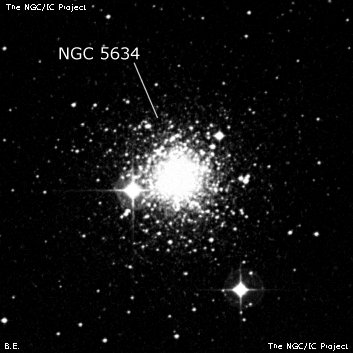
This globular is possibly a former member of the Sagittarius Dwarf Spheroidal Galaxy and appears to be situated in the trailing tidal stream.
William Herschel discovered NGC 5634 = H I-70 = h1813 on 5 Mar 1785 (sweep 380) and recorded "vB, cL, brighter about the middle and the brightness diminishing very gradually, irreg, situated between 3 or 4 considerable stars." There is nothing at his position, but 74 sec of RA west is this globular cluster. John Herschel logged it as "A fine small compressed globular cluster. I can barely discern the stars; the are 19m, 80" diam; has a * 7-8m 90" dist, pos 30° sf, and another 10m np." The latter star is south-preceding."
200/250mm - 8" moderately bright, moderately large. A mag 10 star is on the east edge and a mag 12 star on the west edge.
400/500mm - 17.5" (4/13/96): fairly bright, moderately large, irregularly round, 3.5' diameter. Contains a large bright core of 2' diameter that appears mottled with stellarings or knots. The brightest knot is on the northwest side of the core. Set in a striking field between mag 8.5 SAO 139967 1.4' ESE of the globular and a mag 11 star 1.9' W, with a mag 10 star 3.7' SW of center.
17.5" (6/8/91): bright, round, 3.5' diameter. Situated in a pretty field among three bright stars. The small halo smoothly increases to a broadly concentrated core which is very mottled but not resolved. A few very faint stars are resolved off the edges of the halo at 412x and a star or knot is visible at the west edge of the core.
900/1200mm - 48" (5/10/18): Beautiful globular cluster with 50 stars or more resolved at 375x! Several streams or chains of stars (many easily visible) extend out of the central region, which is densely packed with faint stars over a bright, mottled background glow. A few dozen very dim stars were constantly sparkling in and out of visibility so it wasn't possible to make a decent star count. A very bright orange field star (mag 7.9 HD 127119) is superimposed in the halo on the eastern side [1.4' ESE of center]. Three additional brighter stars in the halo on the west and north side [incl. mag 11.9 star 1.7' NW of center] form a semicircle or crown, partially encircling the halo." The cluster was ~4' diameter, though the outer halo was scraggly without a distinct edge.
Notes by Steve Gottlieb